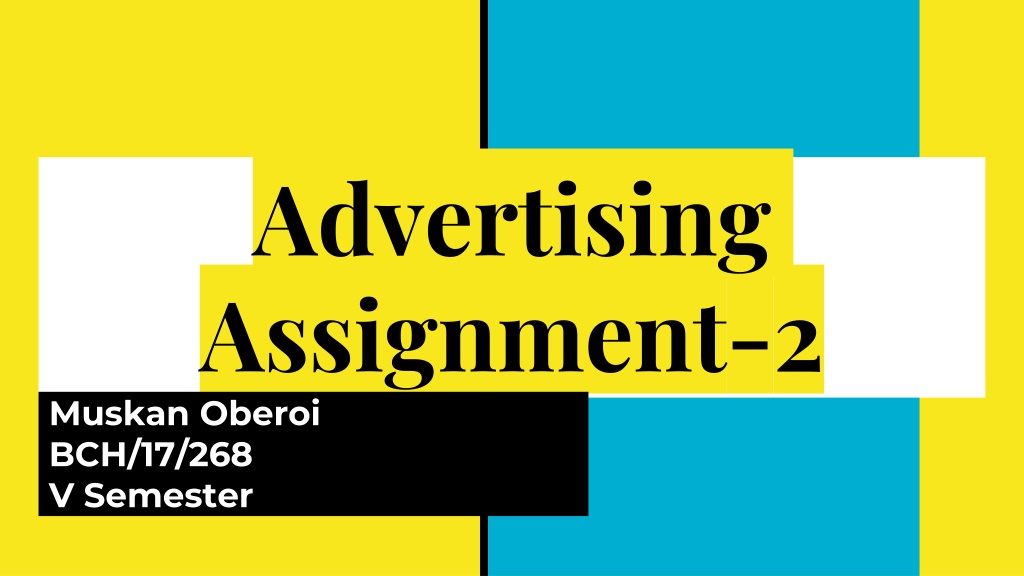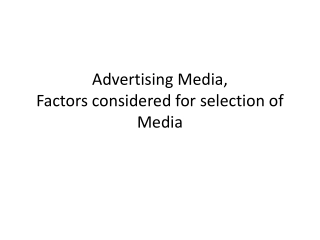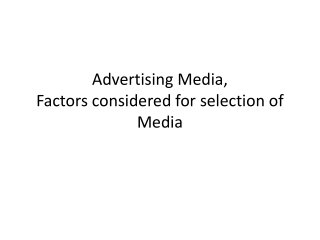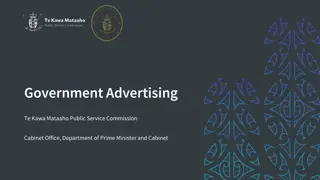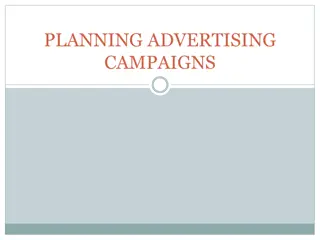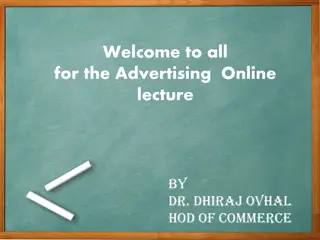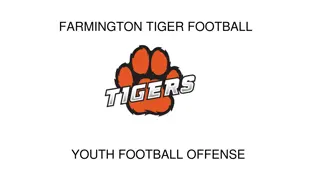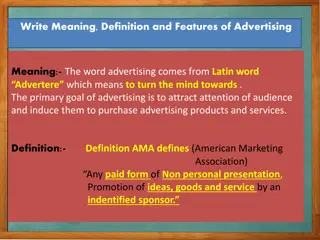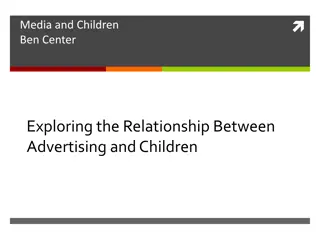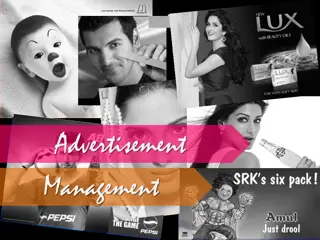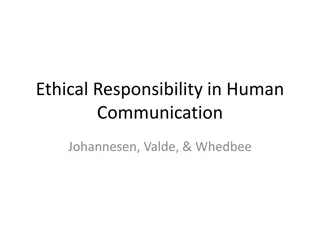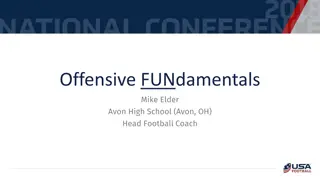Understanding Offensive and Ethical Issues in Advertising
Ads can be offensive and provoke ethical concerns due to their content and presentation, leading to differing perceptions of good taste. Criticism of taste in advertising often revolves around sensitive topics like sex, violence, and brand messaging. The impact of ads can vary based on factors such as audience sensitivity, exposure frequency, and context. It's essential to navigate these issues to create effective and socially responsible advertising campaigns.
Download Presentation

Please find below an Image/Link to download the presentation.
The content on the website is provided AS IS for your information and personal use only. It may not be sold, licensed, or shared on other websites without obtaining consent from the author. Download presentation by click this link. If you encounter any issues during the download, it is possible that the publisher has removed the file from their server.
E N D
Presentation Transcript
Advertising Assignment-2 Muskan Oberoi BCH/17/268 V Semester
Advertising is a means of communication with the users of a product or service. Advertisements are messages paid for by those who send them and are intended to inform or influence people who receive them, as defined by the Advertising Association of the UK.
Social & Ethical Issues of advertising
1) OFFENSIVE OR IN BAD TASTE Ads are often offensive, tasteless, irritating, boring, obnoxious, and so on. Consumers can be offended or irritated by advertising in a number of ways. Some people can get offended by the product or service advertised, while others can get offended by the manner of presentation of the advertisement.
But sometimes, According to my point of view, It is difficult to define terms like offensive or bad taste. We all have our own ideas as to what constitutes good-taste. Unfortunately, because these ideas vary immensely, creating general guidelines for good taste in advertising becomes difficult. What is good taste to some people, is objectionable to others. College students, for example, are not readily offended. They tend to find it amusing or artistic material that arouses cries of outrage from general public. So what might be regarded as clever humour by a group of college students might be considered vulgar by an older age group. Tastes changes with time, income, age and with social changes what is considered offensive today may not be considered offensive in the future.
Criticism of taste in advertising is provoked both by the products themselves and the manner of presentation. The advertisements most often offend people are those emphasizing sex, violence or brand functions. Some advertisements may not be offensive, when people see it for the first time. But it becomes so, if it is hammered into consumer's brain couple of times. Viewers reactions to commercials are also affected by such factors as sensitivity to the product category, time-slot when the message is beamed and whether the person is 'alone or with others.
Examples of some Offensive Advertisements
A)Dove Before & After Dove completely missed the fact that they re implying here that dark skin is dirty. This is an advertisement that shows discrimination, even if that wasn t the message that Dove was trying to send. Unfortunately, the cosmetics brand made the same mistake again in 2017 with a commercial that showed an African- American woman turning into a white one.
Advertisement Link- 1) Dove -https://www.youtube.com/watch?v=zkIrbVycAeM
H&M Coolest Monkey in the Jungle In January 2018, H&M appeared at the center of a racism scandal caused by a printed hooded top with the words coolest monkey in the jungle. Before H&M removed the ad, it was available to everyone on the British version of the online store.
Antonio Federici Submit to Temptation Ice cream manufacturer Antonio Federici missed the mark when they mixed sexual and religious undertones in these inappropriate advertisements. The worst part is the brand is a repeat sinner. In 2010, they ran an ad showing a pregnant nun eating ice cream.
2) SHOCK ADVERTISING Shock advertising or Shockvertising is a type of advertising that "deliberately, rather than inadvertently, startles and offends its audience by violating norms for social values and personal ideals". In our routine life, we come across many advertisements that suddenly get our attention due to the presence of an unexpected factor and this unexpected factor is the main ingredient that turns a normal advertisement into shock advertisement.
Shock factor may be nudity, violation of societal norms, disgusting images, sexual references, vulgarity or moral offensiveness. Shock Advertisements can be shocking and offensive for a variety of reasons, and violation of social, religious and political norms can occur in many different ways. Shock advertising is not for everybody. These advertisements are far more effective amongst younger audiences than older audiences because older people are more likely to be strongly offended by advertisements that include vulgar and obscene material. The shock advertisements create curiosity in youth and become useful in raising awareness.
Negative Impact Sometime people ignore scary and shocking advertisements; they assume that it is not for them as they are not that bad. Shock advertising is like drug addiction; here advertisers also need to increase the dose of shock to get noticed by the viewer because yesterday becomes common today. Using nudity, fear or other strong messages might not always be the best and most effective method to use.
A number of researchers argue that by using offensive advertisements, in the short term a company may be successful in gathering the attention of public and stand out among other advertisers, but in the long run it may face the risk of damaging its customer base and brand image. For example, Sears has stopped selling clothing line of Benetton Group in its 400 stores nationwide because the death-row ads have crossed the line. The people who are offended by shock advertising will not support a cause or purchase a product from a brand using shock advertising.
Positive Impact Shocking ads evokes strong feelings among the consumers & shocking content in an advertisement significantly increases attention, benefits memory & positively influences behavior. Consumers are more likely to remember shocking advertising content over advertising content that s not shocking. This types of advertisement creates a huge amount of publicity and debate. Shock advertising has been using in making people aware about things like harmful practices, life taking diseases, social illnesses in addition to that it s also useful in deeds like donating to charity & helping the needy people. The reason charities sometime use to shock advertisement is fairly obvious.
For example, Purple Focus Pvt. Ltd. in Indore, India created a powerful shock advertisement on the occasion of the WHO's World No Tobacco Day with an aim to educate people about the harmful effects of smoking on family members, especially children.
Examples of some Shock Advertising
NHS - GET UNHOOKED With a slogan of GET UNHOOKED, these print ads from NHS smokefree show young guys and girls literally hooked. And by hooked I mean a painful hook up their lips. The ads say, The average smoker needs over five thousand cigarettes a year. Get unhooked & provide contact information for professional help to quit smoking.I think it's a captivating campaign that not only grabs the attention with its powerful imagery, but also provides a solution to the problem.
Advertisement Link- Get Unhooked- https://www.youtube.com/watch?v=anFK9SA5kKw
Droit des Non Fumeurs- "Smoking is being a slave to tobacco" (France, 2010) France has had a smoking problem history, sometimes being referred to as 'Europe's Chimney'. They had to change tactics, especially since back in 2010 "40 percent of smokers between 12 and 25 are already addicted to cigarettes".Shock tactics were employed to scare audiences into avoiding smoking by linking smoking to sexual slavery. It's fair to say this campaign stirred the media pot quite a bit!
Remi Parola, head of the Non-Smokers' Rights Association that was behind the campaign stated,"We noticed that the traditional anti-smoking campaigns no longer got across amongst the youth. We thus had to use another way in order to raise awareness". However, not everyone had such a positive outlook on the campaigns approach. French Secretary of State for Family Nadine Morano asked for the advert to be banned following the comment, Its purpose was to shock and not convey a message. It is a profoundly mediocre operation . Child welfare group Enfance et Partage said the campaign was cruel and insensitive toward young victims of sexual abuse.
Duncan Quinn - Unnamed (2008) This violent and sexist Duncan Quinn suit advertisement depicting a strangled and bloody half-naked woman lying on a car has been deemed by NYMag as, The most disturbing ad found in December 2008 fashion magazines. I couldn t agree more.The Duncan Quinn ad shows a smug looking man smirking and standing by a car while he holds a necktie around the dead body of a woman who is bleeding from the head, and wearing a bra and a panty.
While accusations of some advertisements are arguably sexist and violent, in part due to cultural differences, this one isn t. The male actor featured in Quinn s ad killed a woman and obviously enjoyed it; he represents a dominate male figure who is superior to women. How, exactly, Duncan Quinn s disgusting violent, shocking and sexist ad showing a murdered woman on a car has anything to do with selling suits completely escapes me.
